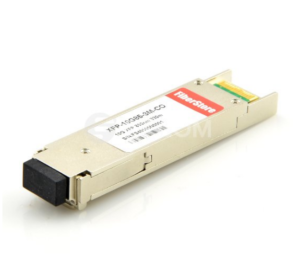There are so many transceivers in FiberStore.Such as SFP Plus transceiver, X2 transceiver, XENPAK transceiver, XFP transceiver, SFP transceiver module (Mini GBIC), GBIC transceiver and so on. But what are fiber optic transceivers do you know? Fiber optic transceiver is a short distance to long distance twisted pair electrical signals and optical signals to be interchanged Ethernet transmission media conversion unit, in many places, also known as media converter. Products are generally used in an Ethernet cable can not be covered, you must use the fiber to extend the transmission distance of the actual network environment, and is usually located in the metropolitan area of broadband access layer applications; while helping the fiber last mile connections to the metro network and more on the outer layer of the network also played a huge role.
In order to ensure the card with other manufacturers, repeaters, hubs and switches and other network equipment is fully compatible fiber optic transceiver products must strictly comply with 10Base-T, 100Base-TX, 100Base-FX, IEEE802.3 and IEEE802.3u Ethernet, etc. web standards, in addition, anti-electromagnetic radiation in the EMC aspects should meet FCC Part15. As the major carriers are efforts to build community networks, campus networks and enterprise networks, so the amount of fiber optic transceiver products are constantly improved in order to better meet the access network construction.
Now on the market most of the optical transceiver supports Pluggable, So, today I will show you some common Pluggable fiber optic transceivers type:
SFP (Small Form-factor Pluggable) Transceiver Module
1,Gigabit optical module, FE SFP optical module, 155Mb SFP optical module, 622Mb SFP optical module, 2.5G SFP optical module: Small pluggable optical transceiver module, LC connector.
2,Gigabit BIDI optical module,Mbps BIDI optical module: BIDI (bidirectional transmission) optical transceiver module, LC connector.
BIDI GEPON OLT optical modules: BIDI GEPON OLT optical transceiver module, SC connector.
3,Gigabit CWDM optical modules: Gigabit CWDM (Coarse Wavelength Division Multiplexing) optical transceiver module, LC connector.
4,Gigabit SFP electrical interface module: RJ-45 Interface
5,Gigabit SFP cable: dedicated to interconnecting devices, hot-swappable
SFP + (10 Gigabit Small Form-factor Pluggable)Transceiver Module
1, SFP + optical modules:10 Gigabit sfp+ module LC interface
2, SFP + cables: dedicated to interconnecting devices, hot-swappable
GBIC (Gigabit Interface Converter, Gigabit Ethernet Interface Converter) Transceiver Module
1, GBIC transceiver modules: hot-pluggable optical transceiver module SC interface
2, GBIC electrical interface modules: hot-pluggable and RJ-45 interface
3,GBIC stacking module: dedicated to interconnecting devices, hot-swappable HSSDC(High Speed Serial Data Connection) Interface
XFP (10 Gigabit Small Form-factor Pluggable,10 Gigabit Ethernet interfaces small pluggable) Transceiver Module
XFP module is 10 Gigabit Ethernet interfaces small pluggable optical transceiver module LC interface
XENPAK (10 Gigabit Ethernet Transceiver Package,10 Gigabit Ethernet interface transceiver collection package) module
Optical transponder, hot-swappable, SC Interface


